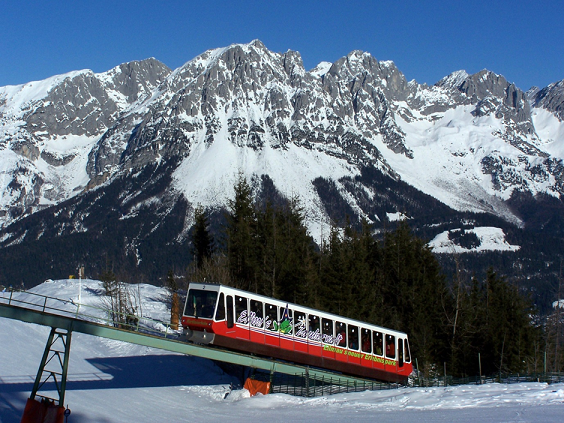
Continuing this series of posts (see here), the idea for funicular at Cairn Gorm was I believe inspired by the Ellmau funicular. A comparison between the two railways is instructive and raises further questions about whether the proposed repairs to the Cairngorm Mountain funicular.
The most outstanding difference is the viaduct itself, steel piers and beams of a much reduced volume, not the massive concrete support used on Cairn Gorm. The original design for the Cairn Gorm Funicular was for steel to be used, but when Morrison’s Construction won the contract they proposed the supports should be constructed out of concrete. This change appears to have been prompted by the initial costings for the funicular construction coming in £2m over budget and was therefore a cost-cutting measure:

The change to concrete was approved by designers A.F.Cruden, seconded by Bullen Consultants and finally approved by Highlands and Islands Enterprise (HIE).
The change from steel to concrete was significant, a “major difficulty” as Keith Bryers described it, because the two materials have very different properties, with steel for example better able to disperse vibrations (see here). As these posts have also shown, the COWI Report suggests that there could have been major flaws in the construction of the concrete bases, piers and beams. This may explain HIE’s pursuit of a legal case on the “design and build aspects of the funicular railway” (as reference in Audit Scotland’s report last year on the funicular). It would be in the public interest to know how much of the current £16m repair bill can be attributed to that initial £2m cost-cutting measure but so far HIE has remained totally silent about this.
It can also be seen from the funimag photo that because the main supports are slimmer and much further apart there is much less of a “snowfence” effect than occurs on Cairn Gorm, a problem that is only going to increase with the proposed propping arrangement.
Propping proposals
While HIE has not revealed the reasons why the concrete funicular supports have failed, we do know part of their proposed solution involves propping up many of the piers.
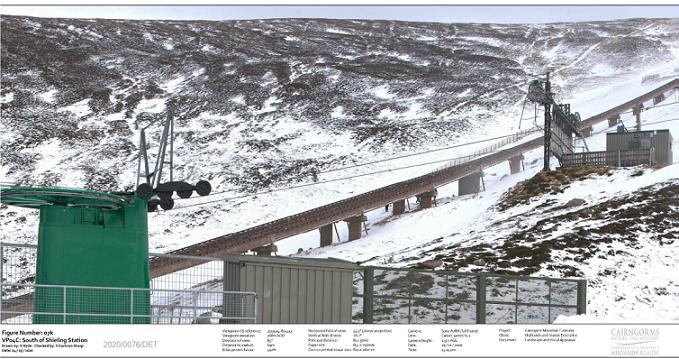
There is currently little information as to what the “propping” entails, apart from the diagrams in the planning application which indicate props of adjustable length will be used.
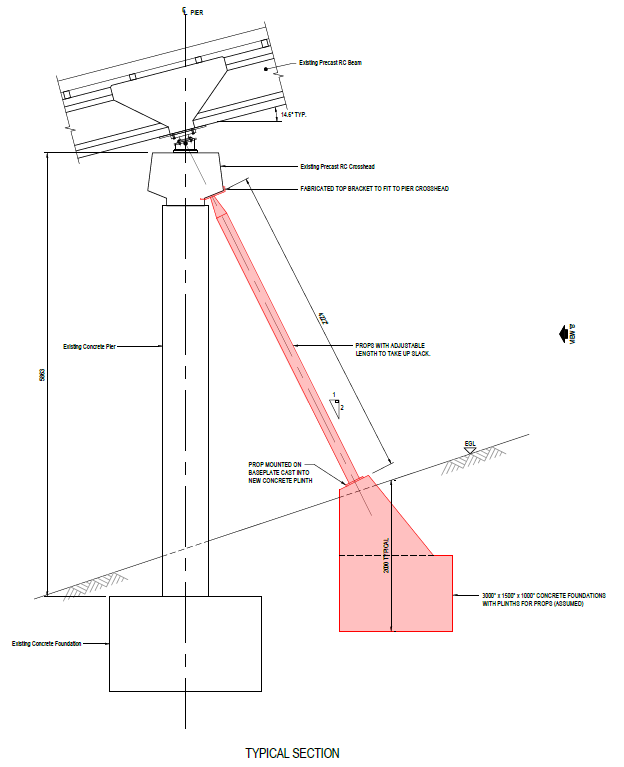
I have therefore looked at what is available:
(1) Steel Acrow type props as shown in the next photo.
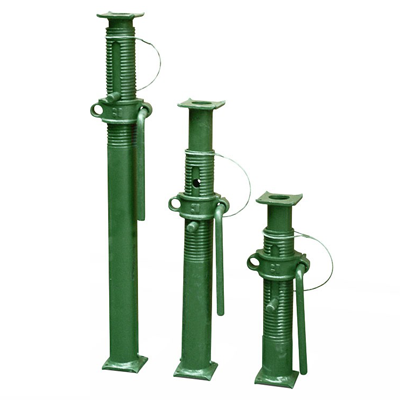
These are adjustable and are the kind of props that are often used on house building projects, e.g. propping up floors when installing patio doors or larger windows. Their use on the Funicular is probably not ideal due to the weight of the track, train etc.
(2) The second type is a combination of the Acrow prop shown above and a hydraulic jack as shown in the next picture:-
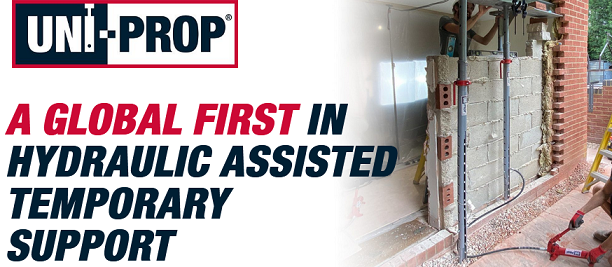
This is a basic model which is obviously not suitable to carry the weight of the funicular, but gives you an idea of what I suspect will be used. They are the only type that appears to meet the specifications in the planning application and COWI report.
There is another major challenge for the propping, apart from the size of the props that will be required, and that is their maintenance and we all know how well that is carried out on Cairn Gorm.
These props and the hydraulic jacks are made of steel which expands and contracts depending on temperature and, as anyone who has skied Cairn Gorm can tell you, there can be quite dramatic changes in temperatures even over the course of a couple of hours. When the sun is out those steel props could be warm to the touch, but if an hour later the temperature has dropped below freezing your hand would stick to them.
The question is will there be a pressure guage in the system so that the jacking pressure exerted on the piers can be monitored and there will be safe limits for that pressure? Too much pressure will push the piers over backwards while not enough and the props will not be doing their job. That is where a major problem arises, even if expansion/contraction was only ¼ ins that would rock the already insecure piers! The answer to that would be to have pressure guages which will need to be monitored on a regular basis, either manually or by an automated system.
Manual monitoring would necessitate a team checking and adjusting the pressures, when necessary, of every propped pier at least every morning before the funicular opens and possibly several times throughout the day! Not too much of a problem when there is snow on the ground as working from the tunnel down, two men on a skidoo, a minute to check each of 65 piers is just over an hour to check all the piers, BUT, what happens when there is no snow? 4 wheel drive vehicles to be used, creating new tracks? Walking the 2000m of the funicular would not be feasible, unless lots of staff were employed to do this.. For a 9.00am opening, staff would have to start checking at 8.00am! But on days when temperatures fluctuated wildly these checks and adjustments would have to be carried out several times a day, an increase in staff hours and therefore maintenance costs.
A fully automated system appears therefore the only sensible option, requiring a system of pipes, valves and electrics running the whole length of the viaduct with automatic shutdown in case of a pipe or fitting failure to avoid a serious ecological incident. It is not clear if HIE has included this in its strengthening/repairs proposals and, if not, how long it expects the repairs to work. It’s hard to see how the piers could possibly last another 30 years if the props are constantly expanding and contracting and the other problems have not been addressed.
What else should HIE have learned from Ellmau?
The Ellmau funicular was removed in 2015 and the article in Funimag, a magazine specifically about Funiculars since 06/01/1996, explains the background and reasons why.
In its 40 years of use, which ended with its removal in 2015, the Ellmau funicular had carried circa 34,000,000 passengers. The Cairngorm Funicular in its 16+ years has carried an average, let’s be generous, of 300,000 people per a year. Even if it carried on at that rate after repair, this would come to a projected total of 12,000,000over 40 years, about 1/3rd of the number carried by the Ellmau funicular!
The Funimag article goes on to explain:-
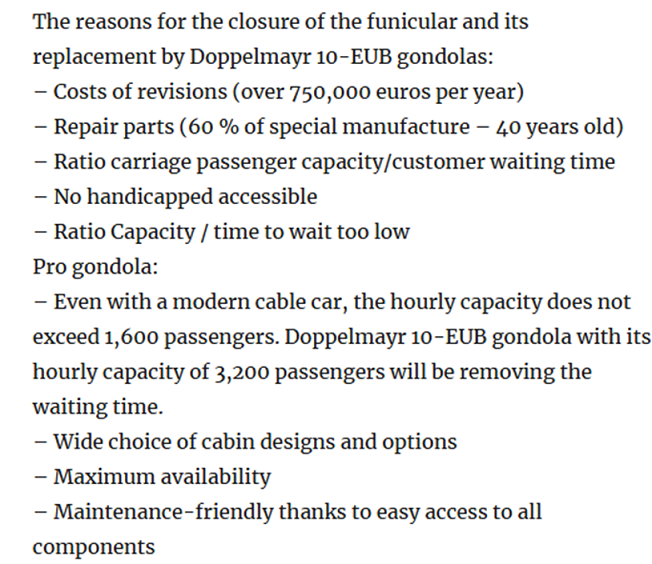
What this says is that a funicular is not an economically viable alternative to a gondola, or even the cheaper chair/ gondola hybrid. Yet despite this information and and its own conclusions in the Full Business Case about the repair costs of the Cairngorm funicular, HIE is insisting that it is returned to service.
The questions that need to be answered
The whole financial and structural failure of the funicular needs to be properly investigated, before any more work is carried out, by financial and civil engineering consultants independent of HIE and its control.
Among the questions that need to be answered are:
- What has caused the structural failure, including the cost-cutting decision to replace steel with concrete?
- How long are the repairs guaranteed to work, or will the public be facing yet another large bill in say 10 or 20 years time?
- The proposals and costs of maintenance going forward, including how the metal props will be adjusted?
- Why HIE has ignored the experience from elsewhere in the world where funiculars are being replaced by other forms of uplift?

Rarely has the phrase ‘throwing good money after bad’ seemed so apt.
The planning applications submitted drawings regarding the steel props state:- “Props with adjustable length to take up slack”, not enough information, anything is speculation. However, in common building practice it will probably be “one size fits all” props to be used instead of custom made specific props for every single position, due to on-site differences in tolerance. The drawing of pier 46 shows a 4.222m long prop which will have a total expansion & contraction range of 2.8mm to 3.4mm over the COWI stated 48C to 57C temperature range. Complex hydraulic systems to take up this amount of slack are not required. In most cases the props will be torqued up to a predetermined load to take into account thermal expansion & any movement, these are common engineering facts/practices.
HIE will never admit that they are wrong.The whole culture of the organisation is holier than thou and HIE knows best.Considering there is not a structural or civil engineer in this organisation of who knows best just shows what an unfit for purpose HIE is.Despite repeated calls to the SNP government to audit and look into the process this has fallen on deaf ears because they would also have to admit that people appointed by them are incompetent.
I despair! As usual technical and proper financial arguments are eclipsed by a scramble to rescue reputations and that’s before we get into the murkier area of partisan politics.
In my 73 years I have seen so many similar stupidities from The Brighton Marina development in my youth, to the corrupt Aviemore Centre Poulson Pottinger saga when working as a ski instructor, to the Cardiff Bay development in my adulthood here in Wales.
There is one theme common to all even outwith the inevitable backhanders, be they financial or in kind; namely pride and a complete lack of humility coupled with an assumption of expertise where there is at best only a journalistic understanding of all the issues.
Please, just for once, can any action be paused while true consideration, detailed investigation of the alternatives and a final recognition that the funicular was an expensive and ill conceived project that must be dismantled.
If reputations suffer, hard luck. Speyside and Scottish skiing deserve better and Holyrood ought to set up an independent review committee of specialists with real teeth, to dictate onward progress. I doubt however that there is the will to do anymore than muddle through wasting money and opportunity.
The consultation which preceded this utterly shambolic and typical farce, seen in many major design/build projects using the UK approach – Dome, Wembly, Cross-Rail, Jubilee Line, HS2, Queensferry Crossing, PFI schools with untied walls etal, had one option on the table which was to build infrastructure into Rothiemurchus and build a tunnel to Coire Cas and up to Ptarmigan. Costs and lack of UK tunnelling experience were voiced as two reasons amongst many, for the idea to be taken off the table.
Now, I think we can see why.
Regardless of the technical problems which are now more like the Gordian Knot, these were more than likely overlooked in preference to the needs of a whole string of vested and invested interests which blinkered the whole decision and design process with a Scottish Government incapable of overseeing this right from the start.
The current repair option is proving to be unworkable and we are being distracted from this core issue by these arcane discussions about props, concrete, foundations and the like – sure, they’re important if they were going to lead to a fabulous, well re-engineered project. But they wont and no one is going to be held to account: least of all our politicians and highly paid appointees of the bodies who are meant to be managing this on behalf of the tax payer.
The pattern of deplorable design and build has got to be stopped now.
Whilst I agree with most of what you say, the Queensferry Crossing was finished more or less on time, given severe weather and on budget as well. A rarity
The queensferry crossing drops blocks of ice onto the road ,cars have been badly damaged they now close it when ice builds up what a great design
No cars have been badly damaged and it has been closed for 24 hours in 3 years. Nothing to do with any design problems. The bridge works. the funicular doesn’t.
In the present over extended fiscal climate it would be a happy outcome for taxpayers, if this farce of incompetence and face saving was brought to some swift conclusion. To proceed with any reinstatement of a flawed inadequate design is gross misuse of Public money. Footfall figures since the funicular first opened have never justified the investment. Throwing more public money at construction companies to repair the shoddy engineering put in place without precedence just to save money, is daft. Unfortunately it is not hard to foresee what is set to happen next. If any attempt to back track is initiated HIE will be placed central in a legal wrangle. Various contracts and agreements already signed will generate dispute. It is not hard to predict that compensation claims for contracts awarded and legal fees to contest commitments made may well soak up much of the approved £14 million budget…the collapsing structure will be cited as vital evidence in legal suits. A decaying public ‘menace’ fenced off on the mountain for another decade at least ? Ultimately, trusting to a new wiser regime at Holyrood funds will be needed yet again -yet more public money -to respect ecological imperatives to remove it.
Luckily over this next period those at the centre of this chaos, the increasingly wealthy officials politicians and consultants, are set to live out their careers and retire happy ! Those Scots wishing to enjoy wintersports will never enjoy any appropriate alternative uplift on Cairngorm. The manner in which this fiasco has run its course will deter investment for ever… nothing else to replace it is ever likely to receive approval or finance.
Tom, there is a possible solution that could stop any legal action. The contractor could be offered a choice. (1) Terminate this contract and go for compensation in a time consuming legal case which will cost everyone money, or, (2) more sensibly, accept the contract to repair the Funicular being terminated and in its place accept a new contract to build new uplift and as a bonus be the contractor to demolish the Funicular. Win win situation for COWI and B.B.? If you were either of these two contractors which would you go for?
In an answer to the question posed by the title “will the repair of the funicular work, from what I have read the proposed repairs are likely to correct one of the fundamental flaws in the design of the Cairngorm Funicular’s substructure which, put simply is an inclined bridge. Funiculars are either built on the ground or on a series of inclined bridges where one end of the section is secured by a large foundation block and the intermediate sections are supported on several pillars, then the next section is started with a large foundation block and so on along the length of the track. With a steel substructure this is done starting at the top so that the steel beams are in tension, but with a concrete substructure, it is started at the bottom so that the concrete beams are under compression. The result of this layout is to convert the vertical force of the carriage and its load (passengers) into a linear force along the length of the beams and a supporting force perpendicular to the beam. This is why, seen in the picture of the Ellmau funicular the supporting pillars are perpendicular to the beams resulting in the supporting load being transmitted directly through the structure. The Cairngorm pillars were built vertical resulting in the pillars having to counter a toppling force, for which I assume, was not adequately allowed for.
The proposed repair using steel struts should be enough to correct this fault in the Cairngorm funicular’s design but unfortunately, I don’t think it is the only fault. Funiculars are best suited to being built on a convex profile and in a straight line. The cairngorm Funicular has a concave profile and follows a double curve along its length. This results in the intermediate pulleys that support and guide the haul ropes, having to cope with misaligned forces acting on them causing premature wear on their rubber liners. Another design fault in the Cairngorm funicular is in the arrangement of the large deflection sheaves that guide the main haul ropes as they enter and exit the drive station positioned at the top end of the funicular. The normal arrangement for these is the two outer sheaves too lie in a vertical plain with the centre sheave lying at a slight angle so that its groove lines up with the two separate drive sheave grooves. This requires three separate shafts, one for each deflection sheave. At Cairngorm, in order to keep the costs down all three sheaves are mounted on the same shaft, again causing premature wear on the drive sheave liners and the resulting ongoing maintenance cost.
As to the question “should the funicular be repaired” I would ask why was it built in the first place when, in the alpine nations, they had had their day. True in the late eighties there was a run of new funiculars but these were unique solutions to problems like glaciers where a funicular running in a tunnel can overcome the problems of trying to build something on top. Cairngorm as Scotland’s “Premier Ski Area” could not be seen to be playing catch up with Aonach Mhor so a Gondola lift was off the cards. With the blinkers on, the Cairngorm management persuaded HIE, with arguments about operation in high winds etc, that a Funicular was just what Cairngorm needed. And so was set in motion the disastrous project that has led to the ruination of Scotland’s Premier Ski Area, the under funding of support to the other four scottish ski areas and a huge dent in Scottish Skiing’s Reputation. In order to save face HIE are now committed to the Funicular as to do anything else would be admitting to have wasted large sums of public money. So the solution is to waste more public money to maybe correct the design faults on a project which had a concept flaw in the first place.
Graham McCabe. Have a look at this video on youtube v=8Fow9PPgg84, especially at 2min28secs and 2min57secs.
Remember that one of the alternative proposals to the funicular was for a gondola starting in Glenmore. It’s not too late to remove every trace of the monstrosity and have a more functional replacement.
Remove the funicular, replace with a 6 seat wide chair, or gondola system, open up the Ciste again, and liberate the White Lady.
Advertised today http://ow.ly/PPBE50DqamO